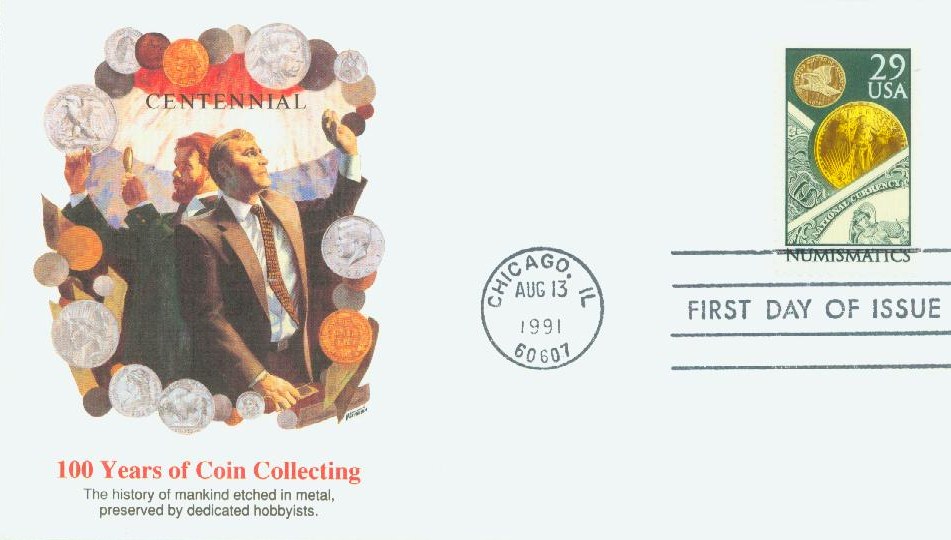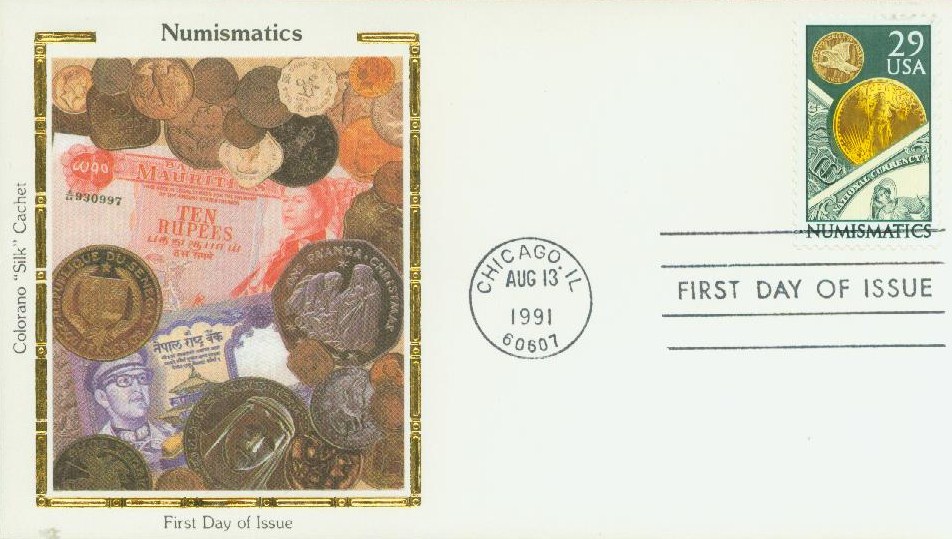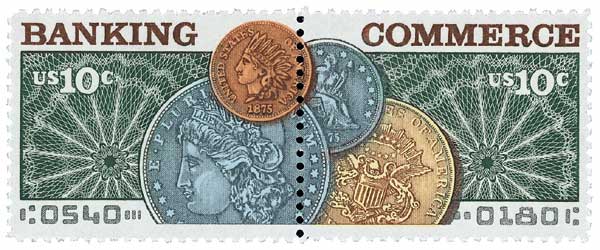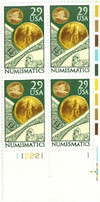
# 2558 - 1991 29c Numismatics
US #2558
1991 Numismatics
- Honors the hobby of coin and currency collecting
- Issued for 100th anniversary of American Numismatic Association
Category of Stamp: Commemorative
Value: 29¢, First-Class Mail rate
First Day of Issue: August 13, 1991
First Day City: Chicago, Illinois
Quantity Issued: 150,310,000
Printed by: Bureau of Engraving and Printing
Printing Method: Lithographed, engraved
Format: Panes of 50 (10 across, 5 down)
Perforations: 11
Reason the stamp was issued: This stamp honors coin and currency collectors. It was issued on the 100th anniversary of the American Numismatic Association.
About the stamp design: The Numismatics stamp was designed by V. Jack Ruther of the BEP. He had designed the Banking and Commerce stamps of 1975 (#1577-78). He borrowed coins from the Smithsonian Institution for the new stamp. Ruther chose coins popular with collectors: the 1907 gold Double Eagle and the 1857 1¢ Flying Eagle. The paper money came from BEP’s own vault. He picked a $10 bill from the Series of 1902 and a $1 US note issued in 1875.
About the printing process: The original die for the Numismatics stamp was engraved in 1975. When the stamp was added to the schedule for 1991, a proof of the original engraving was scanned and some color changes were made. The paper currency was re-engraved, but the coins were produced using offset lithography.
First Day City: The First Day of Issue ceremony took place at the 100th American Numismatic Association convention. The first convention was held in Chicago in 1891, so the stamp was given a Chicago postmark, although the convention was held in nearby Rosemont.
Unusual thing about this stamp: The postmaster general had approved this stamp design in 1977. Plans changed in 1980, when it was decided not to issue the stamp at that time. Ten years later, the subject was brought up again, and the Numismatics stamp design was revealed at the American Numismatic Association convention in Washington state that year. The stamp was finally issued the following year.
History this stamp represents:
In the 1800s, Dr. George F. Heath enjoyed learning world history by studying his coin collection. However, living in a small town in Michigan, it was hard for him to acquire new coins and meet fellow numismatists (coin collectors). At the time, there were numismatic societies in larger cities, but they didn’t reach the smaller towns.
To further his cause, Heath published a four-page leaflet called Numismatist in 1888, in which he included a list of the coins he was in search of, the ones he had for sale, and wrote about coin collecting. Heath’s publication proved popular with hundreds of other coin collectors in similarly isolated areas. His list of subscribers began to grow and he soon realized they should form a national organization. In the February 1891 edition of Numismatist, he asked, “What is the matter with having an American Numismatic Association?” He then responded, “There is nothing like the alliance of kindred pursuits to stimulate growth and interest.”

Heath then called on his readers to meet in Chicago to establish such an organization. And on October 7, 1891, they did. Heath and a group of 61 others met and founded the ANA. Of this event, Heath said, “The foundation of the ANA was not laid for today alone but for the long and distant future as well. Each member can do a little in contributing to its success.”

Heath also suggested that the members of the ANA hold a numismatic convention where they could talk about their hobby and exchange coins. They held conventions each year between 1891 and 1895, and again between 1901 and 1904. Then in 1907, they held a larger convention in Columbus, Ohio, after which they decided to make the event annual.

In 1912, the ANA received a Federal Charter from President William H. Taft. And in 1962, their charter was amended to allow for a larger board of governors. In 1967, the ANA opened its headquarters in Colorado Springs, Colorado.

Today, the ANA continues to issue a monthly journal, The Numismatist. Their headquarters holds the largest circulating numismatic library in the world, which offers books, slides, and videos to members free of charge. The ANA headquarters is also home to the ANA Money Museum, which is home to more than 250,000 items from the history of numismatics. The ANA membership today consists of about 24,000 people around the country.
Click here to discover more from the ANA website.
Click here to see coins on stamps from around the world.
US #2558
1991 Numismatics
- Honors the hobby of coin and currency collecting
- Issued for 100th anniversary of American Numismatic Association
Category of Stamp: Commemorative
Value: 29¢, First-Class Mail rate
First Day of Issue: August 13, 1991
First Day City: Chicago, Illinois
Quantity Issued: 150,310,000
Printed by: Bureau of Engraving and Printing
Printing Method: Lithographed, engraved
Format: Panes of 50 (10 across, 5 down)
Perforations: 11
Reason the stamp was issued: This stamp honors coin and currency collectors. It was issued on the 100th anniversary of the American Numismatic Association.
About the stamp design: The Numismatics stamp was designed by V. Jack Ruther of the BEP. He had designed the Banking and Commerce stamps of 1975 (#1577-78). He borrowed coins from the Smithsonian Institution for the new stamp. Ruther chose coins popular with collectors: the 1907 gold Double Eagle and the 1857 1¢ Flying Eagle. The paper money came from BEP’s own vault. He picked a $10 bill from the Series of 1902 and a $1 US note issued in 1875.
About the printing process: The original die for the Numismatics stamp was engraved in 1975. When the stamp was added to the schedule for 1991, a proof of the original engraving was scanned and some color changes were made. The paper currency was re-engraved, but the coins were produced using offset lithography.
First Day City: The First Day of Issue ceremony took place at the 100th American Numismatic Association convention. The first convention was held in Chicago in 1891, so the stamp was given a Chicago postmark, although the convention was held in nearby Rosemont.
Unusual thing about this stamp: The postmaster general had approved this stamp design in 1977. Plans changed in 1980, when it was decided not to issue the stamp at that time. Ten years later, the subject was brought up again, and the Numismatics stamp design was revealed at the American Numismatic Association convention in Washington state that year. The stamp was finally issued the following year.
History this stamp represents:
In the 1800s, Dr. George F. Heath enjoyed learning world history by studying his coin collection. However, living in a small town in Michigan, it was hard for him to acquire new coins and meet fellow numismatists (coin collectors). At the time, there were numismatic societies in larger cities, but they didn’t reach the smaller towns.
To further his cause, Heath published a four-page leaflet called Numismatist in 1888, in which he included a list of the coins he was in search of, the ones he had for sale, and wrote about coin collecting. Heath’s publication proved popular with hundreds of other coin collectors in similarly isolated areas. His list of subscribers began to grow and he soon realized they should form a national organization. In the February 1891 edition of Numismatist, he asked, “What is the matter with having an American Numismatic Association?” He then responded, “There is nothing like the alliance of kindred pursuits to stimulate growth and interest.”

Heath then called on his readers to meet in Chicago to establish such an organization. And on October 7, 1891, they did. Heath and a group of 61 others met and founded the ANA. Of this event, Heath said, “The foundation of the ANA was not laid for today alone but for the long and distant future as well. Each member can do a little in contributing to its success.”

Heath also suggested that the members of the ANA hold a numismatic convention where they could talk about their hobby and exchange coins. They held conventions each year between 1891 and 1895, and again between 1901 and 1904. Then in 1907, they held a larger convention in Columbus, Ohio, after which they decided to make the event annual.

In 1912, the ANA received a Federal Charter from President William H. Taft. And in 1962, their charter was amended to allow for a larger board of governors. In 1967, the ANA opened its headquarters in Colorado Springs, Colorado.

Today, the ANA continues to issue a monthly journal, The Numismatist. Their headquarters holds the largest circulating numismatic library in the world, which offers books, slides, and videos to members free of charge. The ANA headquarters is also home to the ANA Money Museum, which is home to more than 250,000 items from the history of numismatics. The ANA membership today consists of about 24,000 people around the country.
Click here to discover more from the ANA website.
Click here to see coins on stamps from around the world.












